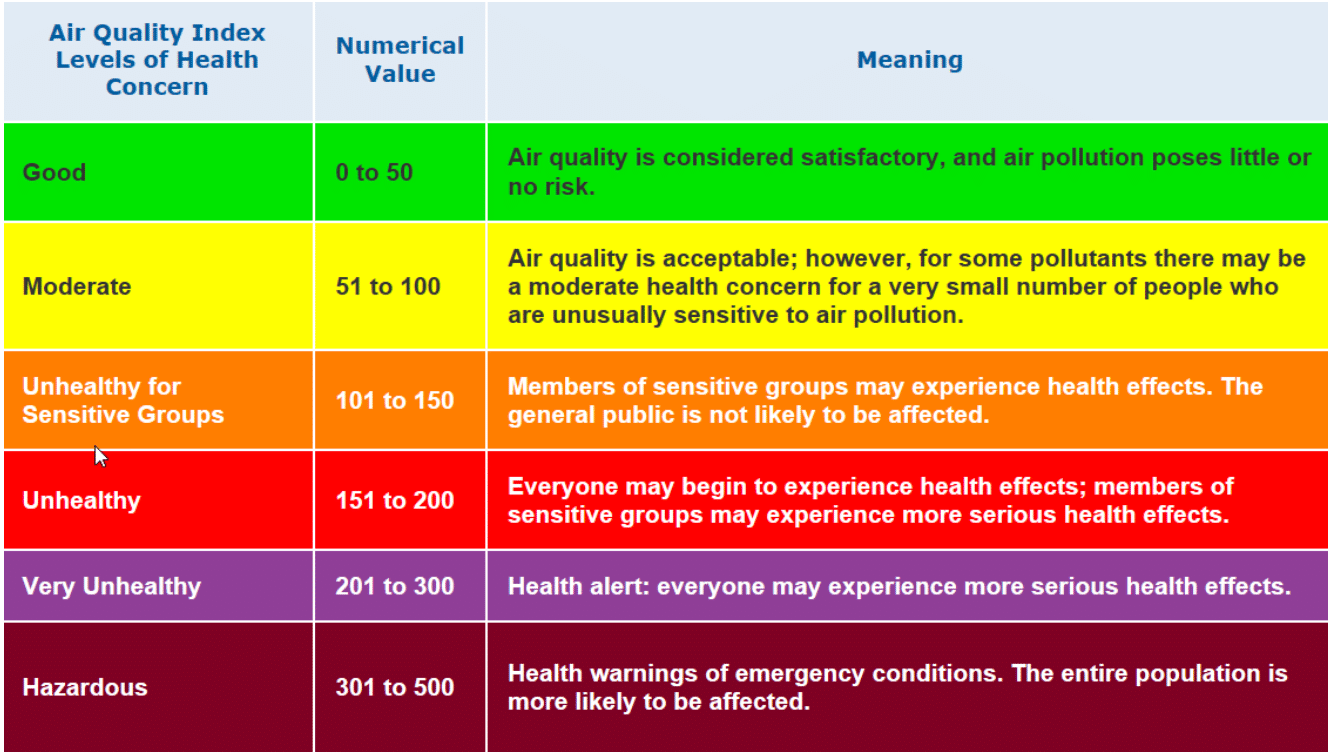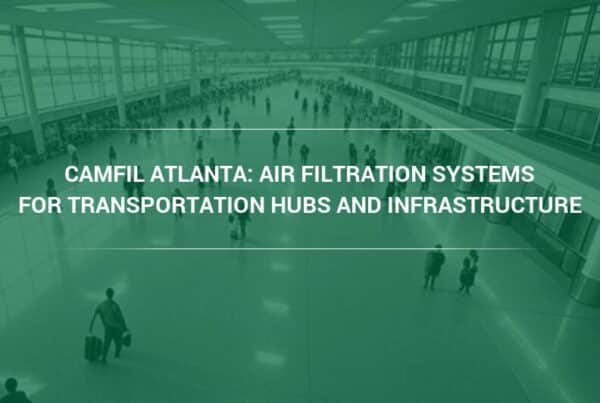Learn What A Code Orange Air Quality Alert Means And When To Use Commercial HVAC Air Filters
Camfil Commercial HVAC air filters news – If you live in a city with severe air pollution, you may occasionally hear that an “orange air quality alert” has been announced. On the days that suffer from the worst air pollution, you may even hear that a “red” air quality alert has been announced in your area.
What does the color of these air quality alerts signify?

What does a code orange air quality alert mean for your health?
The colored air quality alerts are in reference to the Air Quality Index (AQI). The Air Quality Index is a system of rating the safety of the air within a particular region during a particular time. The AQI has several different levels and corresponding color schemes that indicate different concentrations of air pollution and the corresponding level of danger that citizens in the area are in when exposed to these air pollutants. It’s important to know how to interpret the Air Quality Index as it can tell you when to take extra precautions to protect your health. Knowing when it is safe to venture outside or when you should stay indoors and use commercial air filters and industrial air purifiers will minimize your exposure to toxic and deadly air pollutants.
Commercial Air Filtration Systems Deal with The Criteria Air Pollutants
The Air Quality Index was created to advise citizens about the safety of the air within their area. The AQI tracks levels of five different air pollutants: carbon monoxide, sulfur dioxide, nitrogen oxide, ground-level ozone, and particulate matter. These air pollutants fall under the purview of the Clean Air Act, and exposure to them can cause a number of different dangerous health problems. Commercial air filtration systems can filter out all of these pollutants, with the exception of carbon monoxide.
Carbon monoxide (CO) is an odorless, colorless gas that comes from the incomplete combustion of fossil fuels. Any device that burns fossil fuels can release it, though idling vehicles and various industrial processes are common sources of CO. When there are adequate levels of oxygen in an area, carbon monoxide combines with it to become the less dangerous carbon dioxide.
“Both sulfur dioxide and nitrogen oxides are released by fossil fuels used to produce industrial products, create energy, and propel motor vehicles,” says Camfil’s Charlie Seyffer, Manager of Marketing & Technical Materials and 37-year ASHRAE member and active committee participant. “Sulfur dioxide and nitrogen dioxide come more from industrial facilities and fossil fuel-based power plants than they do cars, though cars are still substantial contributors to levels of atmospheric sulfur dioxide and nitrogen oxide. Levels of atmospheric sulfur have dropped significantly since the introduction of cleaner fuels which have reduced sulfur content.” (1)
Ground level ozone, or tropospheric ozone, is created by the interaction of volatile organic compounds (VOCs) with heat and sunlight. Tropospheric ozone is a damaging air pollutant, unlike ozone in the upper atmosphere, which protects us from the sun’s ultraviolet rays. Common sources of VOCs include industrial chemicals, paint, solvents, and gasoline fumes.
Particulate matter refers to any small particles of pollution that are capable of penetrating into people’s lungs and bloodstream, doing damage to the cells of the body. This means PM pollution can encompass a wide variety of different air pollutants. Particulate matter is usually grouped into three different categories, PM1, PM2.5 and PM10. These particles are smaller than 1 µm across, smaller than 2.5 µm across, and smaller than 10 µm across respectively.
Commercial HVAC Air Filters Can Prevent the Development of Asthma and Other Lung Conditions
Commercial HVAC replacement air filters should be used to provide protection against the various air pollutants that the Air Quality Index tracks and reports. Exposure to these air pollutants can cause devastating damage to one’s health, including asthma, pneumonia, and other respiratory or cardiovascular ailments.
Carbon monoxide exposure can quickly lead to nausea, headaches, dizziness, and interrupted thinking. The lungs are being deprived of oxygen as they are exposed to carbon monoxide, so high levels of carbon monoxide exposure can easily be fatal.
“Exposure to sulfur dioxide and nitrogen oxides can cause a number of different respiratory health problems,” says Seyffer at Camfil USA. “Exposure to high levels of the two pollutants can cause difficulty breathing, coughing, and wheezing. These pollutants inflame the linings of the lungs, making them more vulnerable to infection and increasing the incidences of conditions like pneumonia, emphysema, and asthma.” (2)
Exposure to ground level ozone can cause difficulty breathing, much like nitrogen oxide and sulfur dioxide. High levels of ozone exposure can lead to dizziness and headaches. Continued exposure to ground-level ozone over long periods of time can permanently reduce a person’s lung function.
Particulate matter can cause a number of different health problems since it can damage the cells of the body. Particulate matter exposure has been correlated with many different cardiovascular and respiratory ailments like asthma, stroke, heart attack, chronic obstructive pulmonary disorder, and an increased risk of developing lung cancer.
How The Air Quality Index Reflects The Need for Commercial Air Filtration and Ventilation
The Air Quality Index ranks the air in a particular region with one of six different safety levels. These levels reflect the concentrations of air pollutants in that particular region at that particular time. The air quality rankings run from Good to Hazardous and each of them has a color value as well as a number value.
The first level of air quality index is Good air quality, and it covers the air pollution concentrations 0 to 50. Good air quality is represented by the color green on the AQI, and at this level, the air poses no risk to the general health of the population in the region.
The second level of the AQI covers moderate air quality, and the color yellow represents this level on the index. This covers air pollution levels 51 to 100, which means that although the air is generally safe for the majority of the population, those who have unique sensitivities to air pollution should be cautious.
“The third level of the AQI represents air that is unhealthy for certain sensitive groups, and it covers the values 100 to 150,” says Seyffer. “The air in this category isn’t typically harmful to the general populace, but those who are in sensitive groups like children and the elderly should minimize their exposure to the air at this level. It is represented by the color orange on the index.” (3)
The fourth section of the AQI covers the values 151 to 200, and it is represented by the color red on the index. The air quality at this level is dangerous to everyone, and those who are at special risk from air pollutants can begin to have serious health damage occur.
The fifth section of the AQI is represented by the color purple on the index and it contains all of the values which run from 201 to 300. Air at this level of pollution is dangerous to the entire population, and everyone may have severe health damage occur if exposed to it for long periods of time.
The sixth and final section of the AQI contains all pollutant values above 300. It appears as the color maroon on the index, and the air here is extremely hazardous. Air quality at this level is classified as emergency conditions and everyone should limit their exposure to it, as they are likely to be severely impacted by it.
What Commercial Air Filtration Units Should Be Used?
As the levels of air pollution increases, commercial air filtration units become more and more important for protecting people’s health from exposure to air pollutants like particulate matter and the other criteria air pollutants. Commercial air filters are rated with the MERV system which stands for Minimum Efficiency Reporting Value. The higher a filter’s MERV number is, the more particles of pollution it can remove.
“Filters rated 8 – 13 MERV are typically sufficient for use in most HVAC systems and will do an adequate job filtering particulate air pollutants,” Seyffer. “Yet those who live in areas where the air quality index reaches orange or higher may choose to employ industrial level HEPA air filters. HEPA stands for High-Efficiency Particulate Air, and these filters can absorb up to 99.97% of all pollutants as small as 0.3-micron in size. HEPA filters can be used in HVAC systems or as part of a portable air purifier.” (4)
Those who are considering buying a HEPA air filter should do their research and be sure that the filters are genuine HEPA filters. This is because some filters may advertise themselves as being “HEPA-like”, meaning that though superficial aspects of their design are similar to HEPA filters they can’t actually trap the smallest and most dangerous particles.
Commercial Air Purifiers by Themselves Aren’t Enough to Stay Safe
While commercial air purifiers can help protect you from the harmful pollutants tracked by the AQI, they shouldn’t be your only line of defense. It’s also important to monitor and understand the Air Quality Index, staying up-to-date on air quality reports in your region. The level of air pollution in your region will affect which steps you want to take to minimize your exposure to air pollutants.
The first couple levels of the AQI represent fairly clean air, which will pose little threat to your health unless you have a pre-existing respiratory condition. Yet beginning at the orange level of air pollution, you should begin taking steps to limit your exposure to air pollutants. Try to confine your periods of outdoor activity to early morning when air pollution levels are lowest, and stay away from major thoroughfares as concentrations of air pollutants are highest around them.
When air pollution levels are at either the very unhealthy or hazardous levels, limit the amount of time spent outdoors if possible. Portable industrial air purifiers can be used in the home to augment the cleaning capabilities of filters in home HVAC systems. Industrial grade facemasks can also be used to reduce the amount of pollution one breathes in if you have to venture outside in extreme air pollution.
Camfil USA commercial or industrial air filters can help you decide on the right level of filter for you, based on the AQI reports for your area. Contact Camfil USA industrial air filters today to have a professional help you choose the right air filter for your needs.
Lynne Laake
T: 888.599.6620,
E:Lynne.Laake@camfil.com
F: Friend Camfil USA on Facebook
T: Follow Camfil USA on Twitter
Y: Watch Camfil Videos on YouTube
Sources:



